2018 Chevrolet Traverse V-6 FWD
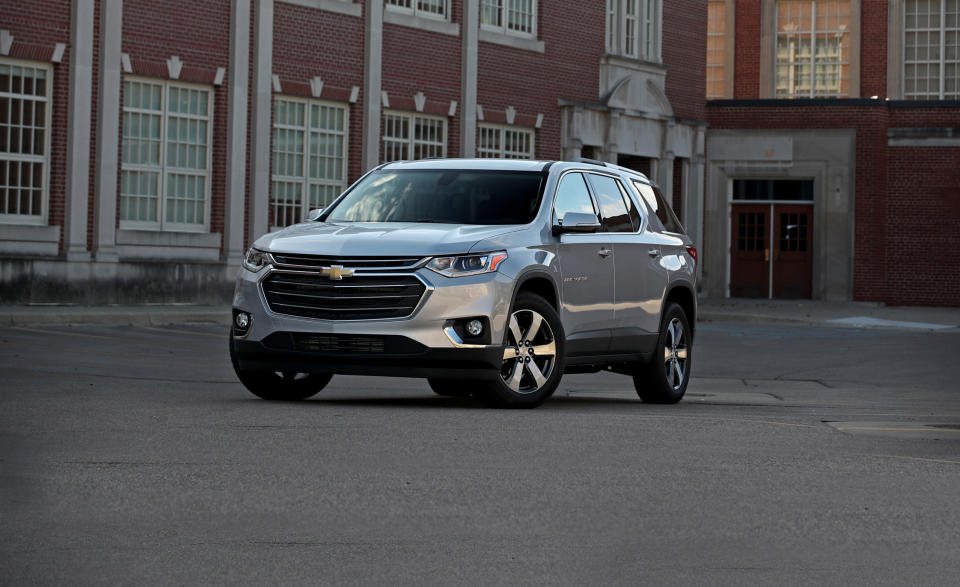
Most homeowners who’ve shopped for appliances will agree that finding a nice-looking, durable, and high-quality refrigerator for a decent price is a challenge, despite the plethora of options lining the aisles at the local big-box retailer. Likewise, those shopping three-row family crossovers are met with a similarly bewildering array of choices. The Chevrolet Traverse, which has been redesigned for 2018, has set itself up to be a go-to option for buyers in that segment.
Like those nonautomotive appliances, the Traverse is available across a broad swath of price points. The lineup spans from the basic L—which starts at a paltry $30,925—to the loaded and luxurious High Country, which crests the $53,000 mark, with five midrange options in between. Of these, the LT Leather is the one General Motors expects will be the volume seller, the automotive equivalent to a Frigidaire side by side. (GM used to know a lot about refrigerators, too, having owned Frigidaire from 1919 until 1979.)
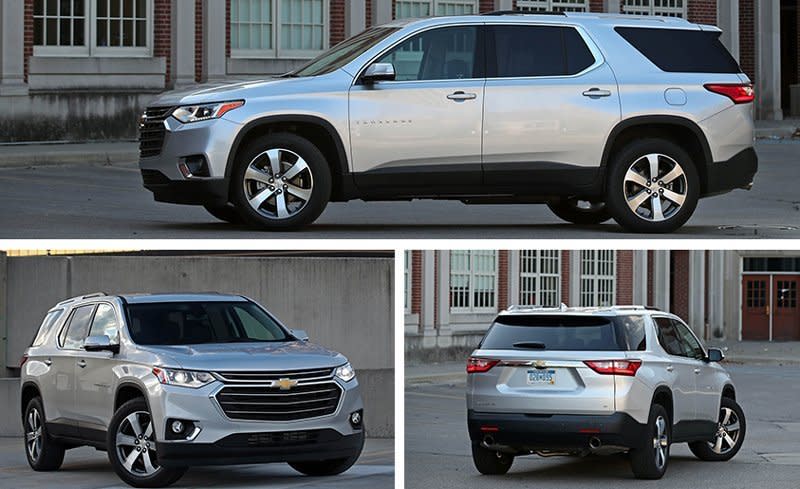
Our $42,835 front-wheel-drive LT Leather test vehicle sported just two options: a $650 Trailering Equipment package (a trailer-hitch receiver and a heavy-duty cooling system granting a bump in towing capacity from 1500 to 5000 pounds) and a $40 front-license-plate mount. This Traverse has features that most anyone considering a modern three-row family vehicle will want: touchscreen infotainment with navigation, a power liftgate, second-row captain’s chairs, heated front seats, and flashy 20-inch aluminum wheels. Going with front-wheel drive rather than four driven wheels saves $2000 on the LT Leather—more on the Premier trim level, where all-wheel drive is bundled with additional equipment.
Get the Lead Out
The front-drive Traverse uses the same 310-hp 3.6-liter V-6 and nine-speed automatic as the all-wheel-drive High Country example we recently tested. The EPA rates the front-driver at 18 mpg city and 27 highway, versus 17/25 mpg city/highway for the all-wheel-drive version. On our 75-mph highway fuel-economy test, the Chevy just missed its EPA mark with a still respectable 26 mpg.
The 3.6-liter V-6 pulls strongly, and the low-end power is handy around town. The nine-speed cycles smoothly through its gears, but stand on the throttle and the FWD Traverse exhibits distinct torque steer that’s not present in the all-wheel-drive version, although it is quicker to 60 mph by 0.2 second, nailing the mark in a fleet 6.3 seconds.

In fact, the lighter front-drive LT outperformed the luxed-up all-wheel-drive version’s acceleration times across the board, albeit slightly. In our 70-mph-to-zero emergency braking test, the two-wheel-drive Traverse halted in 170 feet, six feet shorter than the all-wheel-drive Traverse and 11 feet shorter than a front-wheel-drive Honda Pilot. One thing that both Traverses shared was significant brake fade after six hard stops.
Dynamically, the Traverse disguises its size quite well. Its steering is light but there is more feedback than you might expect from a large crossover’s helm. The ride is refined, soaking up all but the harshest bumps without disturbing occupants—a plus for those with young children who are easily awakened. Even so, the Traverse is still a large family SUV, so driving enthusiasts shouldn’t expect to be particularly entertained behind the wheel.
It’s What Inside That Counts
The cabin is designed with simplicity in mind. Up front are two spacious, comfortable, and heated bucket seats, and the driver faces a minimalist gauge cluster that’s easy to read at a glance. The all-black color scheme of our test car fell somewhere between bland and boring, while the interior’s materials appeared chosen more for their durability than their luxuriousness.
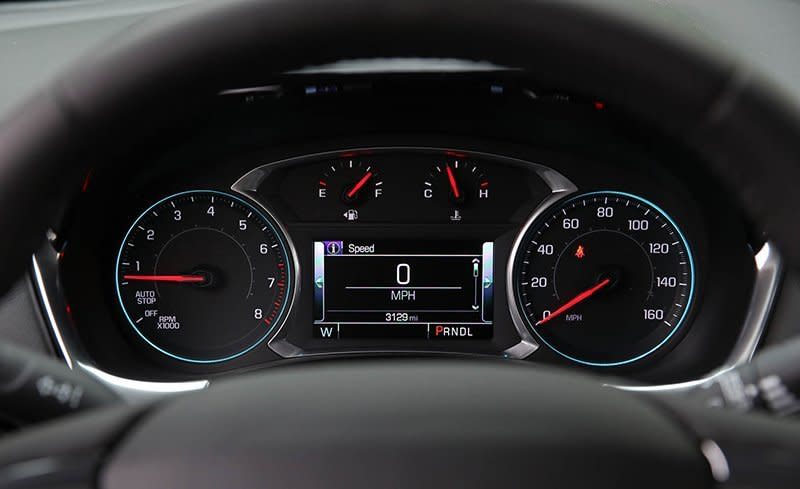
Second-row passengers are treated to captain’s chairs that slide fore and aft as well as recline (a bench can be optioned on the LT and is standard on the L and LS). It’s another spacious row of seating that adults should find comfortable for even long journeys, although seat padding here isn’t as generous as in the front seats. Climbing into the Traverse’s third row is made easy by sliding one of the second-row seats that moves out of the way to create a wide opening. Unfortunately, this mechanism is fitted only to the passenger’s side—an odd decision on Chevy’s part.
Third-row passenger space is above average for the segment, but adults will still feel the pinch and might struggle to find a comfortable seating position. With the second-row seats moved forward on their tracks, legroom is merely adequate, and long-legged passengers will find their knees elevated and pressed into the second-row seatbacks. The Volkswagen Atlas’s exterior measurements are a bit smaller, but it manages to better accommodate adults in its third row, which also is easily accessible from both sides of the vehicle.
Drop all the rear seatbacks and the Traverse’s interior transforms into a vast, 98-cubic-foot cargo bay—the largest in the segment, beating the Atlas by one cubic foot. Liftover height is a reasonably low 30.5 inches, and there’s virtually no lip, making it easier to slide heavy items into the back. During our practical-space testing, the Traverse swallowed an impressive 38 carry-on suitcases, tying the Atlas and the Honda Pilot. Neither of those crossovers can hold as many as the Traverse can—six suitcases—behind the third row, however. A bevy of interior storage cubbies—including a neat compartment hidden behind the infotainment screen, which motors up—provide ample space for stashing smartphones, toys, snacks, and other family and travel-related detritus.
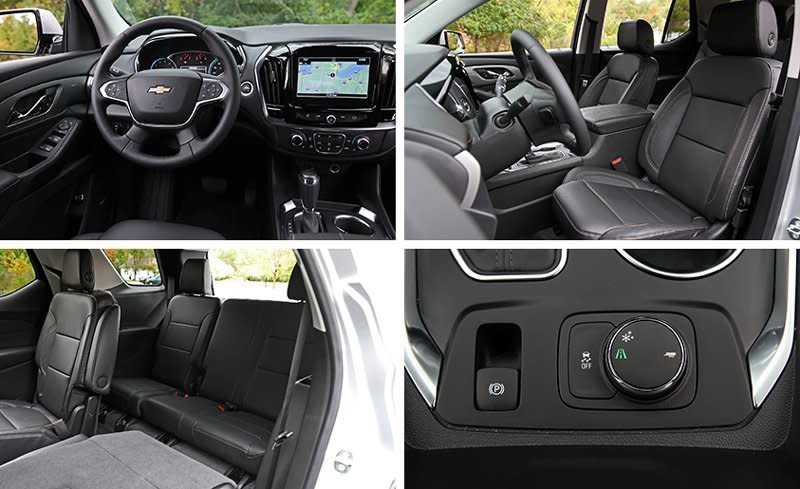
Tech Savviness Comes Standard
Chevrolet’s MyLink infotainment system plays on a large 8.0-inch touchscreen in the LT Leather trim level, and it comes standard with navigation, Apple CarPlay, and Android Auto. The interface is easy to use while driving thanks to large, color-coded icons that are easily identified in the driver’s peripheral vision. The software is quite responsive as well, registering an average menu-to-menu response time of just 0.4 second in our testing. Also impressive are the Traverse’s standard seven USB ports strategically placed throughout the cabin and an onboard Wi-Fi hotspot—everyone’s mobile device can remain powered, connected, and pacifying.
The infotainment screen also serves as a display for the standard backup camera and, in our test vehicle, a 360-degree monitor. The image quality is surprisingly grainy and low-res, which is a disappointment considering the rest of the Traverse’s suite of technology is near the top of the class. The novel rearview mirror (which Chevy calls Rear Camera Mirror) can be switched to a display screen that provides a wide-angle view behind the vehicle; it’s activated with the flip of a switch. The image displayed there is of higher quality than the disappointing backup camera, and it’s handy for times when tall cargo or rear-seat passengers’ heads make seeing via the traditional mirror difficult.
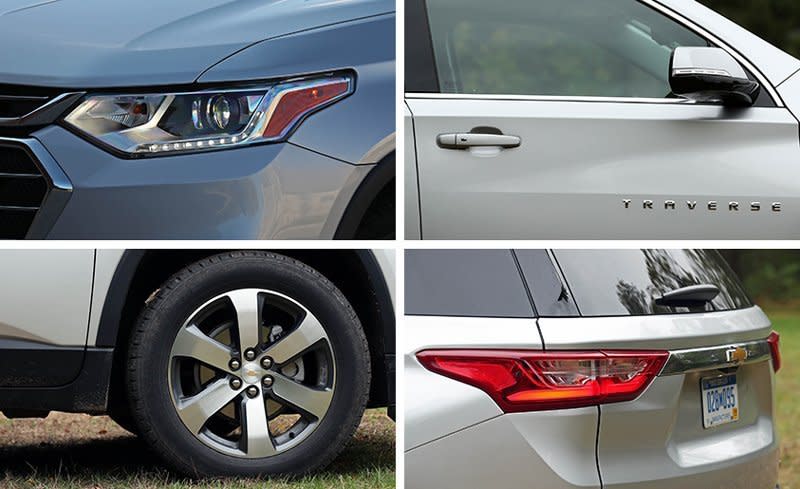
For all the Traverse’s focus on infotainment technologies, it’s surprising that buyers won’t find similarly desirable active-safety features at this level in the Traverse hierarchy. Blind-spot monitoring with rear cross-traffic alert is standard on the LT Leather, but camera- and radar-based gizmos, such as automated emergency braking and adaptive cruise control, are reserved for the expensive Premier and High Country models. Both the Honda Pilot and the Kia Sorento offer these items—at least as options—on all but their base models. Eventually, automated emergency braking will be standard on all new vehicles sold in the United States, but that’s a few years off.
In cars, as with appliances, researching choices and compromising is a necessary part of the shopping process for the vast majority of buyers. For those who need to maximize cargo space and passenger-hauling ability, there are few choices outside of a minivan that offer a similarly practical package as the Traverse, and its few missteps represent small trade-offs. Chevrolet has a winner on its hands with the new Traverse, and it should serve its wide audience just fine.
Specifications >
VEHICLE TYPE: front-engine, front-wheel-drive, 7-passenger, 4-door hatchback
PRICE AS TESTED: $42,835 (base price: $30,925)
ENGINE TYPE: DOHC 24-valve V-6, aluminum block and heads, direct fuel injection
Displacement: 218 cu in, 3564 cc
Power: 310 hp @ 6800 rpm
Torque: 266 lb-ft @ 2800 rpm
TRANSMISSION: 9-speed automatic with manual shifting mode
DIMENSIONS:
Wheelbase: 120.9 in
Length: 204.3 in
Width: 78.6 in Height: 70.7 in
Passenger volume: 157 cu ft
Cargo volume: 23 cu ft
Curb weight: 4443 lb
C/D TEST RESULTS:
Zero to 60 mph: 6.3 sec
Zero to 100 mph: 16.6 sec
Zero to 120 mph: 32.4 sec
Rolling start, 5–60 mph: 6.5 sec
Top gear, 30–50 mph: 3.1 sec
Top gear, 50–70 mph: 4.4 sec
Standing ¼-mile: 14.9 sec @ 95 mph
Top speed (governor limited): 130 mph
Braking, 70–0 mph: 170 ft
Roadholding, 300-ft-dia skidpad: 0.82 g
C/D FUEL ECONOMY:
Observed: 18 mpg
75-mph highway driving: 26 mpg
Highway range: 500 miles
EPA FUEL ECONOMY:
Combined/city/highway: 21/18/27 mpg

 Yahoo Autos
Yahoo Autos 